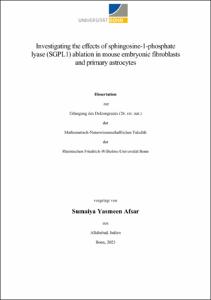Investigating the effects of sphingosine-1-phosphate lyase (SGPL1) ablation in mouse embryonic fibroblasts and primary astrocytes

Investigating the effects of sphingosine-1-phosphate lyase (SGPL1) ablation in mouse embryonic fibroblasts and primary astrocytes

| dc.contributor.advisor | van Echten-Deckert, Gerhild | |
| dc.contributor.author | Afsar, Sumaiya Yasmeen | |
| dc.date.accessioned | 2023-09-13T14:44:56Z | |
| dc.date.available | 2023-09-13T14:44:56Z | |
| dc.date.issued | 13.09.2023 | |
| dc.identifier.uri | https://hdl.handle.net/20.500.11811/11039 | |
| dc.description.abstract | Sphingosine-1-phosphate (S1P) is a bioactive lipid that plays a crucial role in various fundamental processes, including cellular proliferation, survival, migration, as well as inflammation. Additionally, it has been implicated in the development and progression of cancer as well. S1P metabolism, regulated by S1P-lyase (SGPL1) and its receptors, S1PR1–5, plays a critical role in maintaining cellular homeostasis. In this study, the impact of S1P on glucose metabolism was investigated using SGPL1-deficient mouse embryonic fibroblasts (Sgpl1-/- MEFs). SGPL1 deficiency lead to accumulation of S1P which activates hypoxia-inducible factor 1 (HIF-1) and promotes the expression of glucose metabolism-related proteins through S1PR1–3 receptors, leading to increased glucose-to-lactate conversion and cell proliferation, resembling cancer cells. Importantly, these metabolic changes did not negatively affect cellular energy status, as indicated by Akt/mTOR pathway activation and downregulation of autophagy. These results reveal a distinctive role of the S1P/S1PR1–3 axis in glucose metabolism in SGPL1-deficient MEFs.
Moreover, the role of S1P in different neurodegenerative diseases is not yet clear, as there are contrasting findings. On the one hand it was shown to be crucial for brain development. Lack of S1P during embryonic development is extremely dangerous and can cause the failure of various essential processes, such as the closure of the front part of the neural tube. On the other hand, an excessive amount of S1P, due to mutations in the SGPL1 responsible for its cleavage, is also detrimental. It is worth mentioning that the SGPL1 gene is located in a region of the genome that is prone to mutations found in several types of human cancers. Additionally, mutations in SGPL1 can lead to a condition called S1P-lyase insufficiency syndrome (SPLIS), which is characterized by various symptoms, including neurological defects in both the peripheral and central nervous systems. This study shows the impact of S1P lyase in astrocytes derived from neural-targeted SGPL1 deficient mice (SGPL1fl/fl/Nes). SGPL1 deficiency led to S1P accumulation, resulting in increased expression of glycolytic enzymes similar to MEFs. However, in SGPL1-deficient astrocytes, pyruvate utilization was through tricarboxylic acid (TCA) cycle via S1PR2,4 receptors. This metabolic shift increased cellular ATP content and activated the mammalian target of rapamycin (mTOR), thus affecting autophagy in astrocytes. Furthermore, elevated extracellular ADP levels, mediated by the purinoreceptor P2Y1 (P2Y1R) in SGPL1-deficient astrocytes induced astrogliosis and 6 NLRP3 inflammasome activation, leading to the generation of proinflammatory cytokines. These findings shed new light on the oncogenic implications of S1P metabolism and present opportunities for modulating membrane lipid composition as well as offer valuable insights into the interplay between astrocyte functionality and NLRP3 inflammasome. Targeting S1P metabolism and signaling pathways could potentially serve as novel therapeutic approaches and contribute to a better understanding of S1P function not only in brain pathology but also with regard to the complex phenotype of patients exhibiting mutations in SGPL1. | en |
| dc.language.iso | eng | |
| dc.rights | In Copyright | |
| dc.rights.uri | http://rightsstatements.org/vocab/InC/1.0/ | |
| dc.subject.ddc | 570 Biowissenschaften, Biologie | |
| dc.title | Investigating the effects of sphingosine-1-phosphate lyase (SGPL1) ablation in mouse embryonic fibroblasts and primary astrocytes | |
| dc.type | Dissertation oder Habilitation | |
| dc.publisher.name | Universitäts- und Landesbibliothek Bonn | |
| dc.publisher.location | Bonn | |
| dc.rights.accessRights | openAccess | |
| dc.identifier.urn | https://nbn-resolving.org/urn:nbn:de:hbz:5-72107 | |
| dc.relation.doi | https://doi.org/10.3390/ijms24054581 | |
| dc.relation.doi | https://doi.org/10.1002/1878-0261.13300 | |
| dc.relation.doi | https://doi.org/10.1002/1878-0261.13063 | |
| ulbbn.pubtype | Erstveröffentlichung | |
| ulbbnediss.affiliation.name | Rheinische Friedrich-Wilhelms-Universität Bonn | |
| ulbbnediss.affiliation.location | Bonn | |
| ulbbnediss.thesis.level | Dissertation | |
| ulbbnediss.dissID | 7210 | |
| ulbbnediss.date.accepted | 30.08.2023 | |
| ulbbnediss.institute | Mathematisch-Naturwissenschaftliche Fakultät : Fachgruppe Molekulare Biomedizin / Life & Medical Sciences-Institut (LIMES) | |
| ulbbnediss.fakultaet | Mathematisch-Naturwissenschaftliche Fakultät | |
| dc.contributor.coReferee | Menche, Dirk | |
| ulbbnediss.contributor.orcid | https://orcid.org/0000-0003-1378-787X |
Files in this item
This item appears in the following Collection(s)
-
E-Dissertationen (4104)




